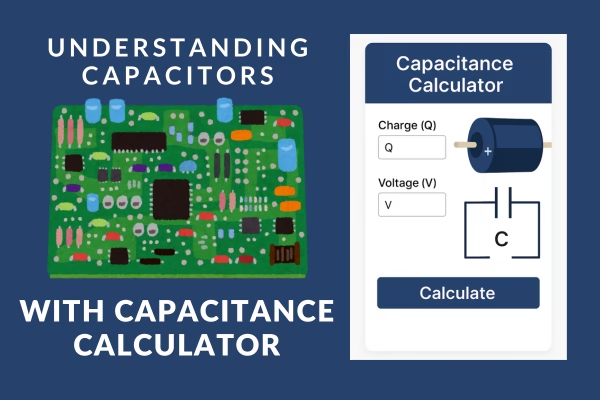What is a Capacitor?
Complete guide to understanding capacitors with interactive calculators and practical applications
📋 Table of Contents
What is a Capacitor?
A capacitor is a fundamental electronic component that stores electrical energy in an electric field between two conductive plates separated by an insulating material called a dielectric. Think of it as a temporary electrical storage device that can quickly charge and discharge energy.
Unlike batteries, which store energy chemically and provide a steady voltage over time, capacitors store energy electrostatically and can release it almost instantaneously. This unique characteristic makes them invaluable in countless electronic applications.
How Do Capacitors Work?
The basic principle behind capacitor operation is relatively simple. When a voltage is applied across the capacitor's terminals, electrons accumulate on one plate (making it negatively charged) while the other plate loses electrons (becoming positively charged). The dielectric material between the plates prevents electrons from flowing directly between them, creating an electric field that stores energy.
C = Q / V
Where C = Capacitance (Farads), Q = Charge (Coulombs), V = Voltage (Volts)
Types of Capacitors
Ceramic Capacitors
Small, inexpensive, and reliable. Made with ceramic dielectric material. Commonly used in high-frequency applications and decoupling circuits.
Electrolytic Capacitors
High capacitance values in compact sizes. Polarized components used in power supply filtering and energy storage applications.
Film Capacitors
Excellent stability and low loss. Made with plastic film dielectrics. Ideal for precision applications and audio equipment.
Tantalum Capacitors
High capacitance density and stable performance. Used in space-constrained applications like mobile devices and computers.
Capacitance Calculators
Calculate capacitance using multiple methods. Choose the calculator that matches your application.
Basic Capacitance Calculator
Calculate capacitance using charge and voltage values
C = Q / V
Where C = Capacitance (F), Q = Charge (C), V = Voltage (V)
Frequently Asked Questions
Get answers to the most common questions about capacitors and their applications.
Practical Capacitor Testing Methods
Learn how to test capacitors safely and effectively using various methods and tools.
1. Multimeter Capacitance Test
Best for: Quick, accurate capacitance measurement
Method: Set multimeter to capacitance mode (F symbol), discharge the capacitor, connect test leads to capacitor terminals, and read the displayed value. Compare with the rated capacitance (usually within ±20% tolerance).
What to look for: Readings significantly below rated value indicate a failing capacitor.
2. Analog Multimeter Charging Test
Best for: Basic functionality test when capacitance meter unavailable
Method: Set analog multimeter to high resistance range (x10k ohms), connect leads to capacitor terminals. The needle should deflect toward zero then slowly return toward infinity as the capacitor charges.
What to look for: No deflection indicates an open capacitor; needle stays at zero indicates a shorted capacitor.
3. ESR Meter Test
Best for: Detecting capacitors with correct capacitance but high internal resistance
Method: Use specialized ESR meter to measure equivalent series resistance. This test can be performed in-circuit without removing the capacitor.
What to look for: ESR values significantly higher than manufacturer specifications indicate aging or failing capacitors.
4. Visual Inspection
Best for: Quick identification of obviously failed capacitors
Method: Look for physical signs of failure: bulging tops, leaking electrolyte, burn marks, or cracked cases.
What to look for: Any visible damage usually indicates the capacitor needs replacement.
5. Insulation Resistance Test
Best for: High-voltage capacitors and insulation quality assessment
Method: Use insulation resistance tester (megohmmeter) to measure leakage current between terminals and case.
What to look for: Low insulation resistance indicates dielectric breakdown or contamination.
Capacitor Troubleshooting Guide
Common capacitor problems and their solutions in various applications.
Problem: Motor Won't Start
Likely Cause: Failed start capacitor or run capacitor
Solution: Test capacitor with multimeter. Replace if capacitance is below 80% of rated value. Check connections for corrosion or loose terminals. Ensure voltage rating matches or exceeds original specification.
Problem: Power Supply Ripple/Noise
Likely Cause: Failing filter capacitors with high ESR
Solution: Measure ESR of filter capacitors. Replace capacitors with ESR above manufacturer specifications. Use low-ESR capacitors for switching power supplies. Check for proper grounding and layout.
Problem: Circuit Timing Issues
Likely Cause: Capacitor value drift or leakage
Solution: Measure actual capacitance and compare to design requirements. Check for leakage current. Replace with precision capacitors if timing is critical. Consider temperature coefficient effects.
Problem: Reduced Power Factor
Likely Cause: Failed power factor correction capacitors
Solution: Test power factor correction capacitor bank. Replace failed units with same voltage and capacitance ratings. Check for harmonic distortion that may affect capacitor life.
Problem: Audio Distortion or Loss
Likely Cause: Coupling capacitor failure or value change
Solution: Test coupling capacitors for correct value and low leakage. Replace with appropriate type (film capacitors for audio applications). Check for DC bias effects on electrolytic capacitors.
Problem: Capacitor Overheating
Likely Cause: Excessive current, wrong type, or overvoltage
Solution: Verify voltage rating is adequate (use 125-150% of operating voltage). Check current rating for AC applications. Ensure proper ventilation. Consider using capacitors with higher temperature ratings.
Key Parameters
Capacitance
Measured in Farads (F), capacitance indicates how much charge a capacitor can store per volt applied. Common units include microfarads (μF), nanofarads (nF), and picofarads (pF).
Voltage Rating
The maximum voltage that can be safely applied across the capacitor without risk of breakdown or damage. Always use capacitors with voltage ratings higher than your circuit's operating voltage.
ESR (Equivalent Series Resistance)
The internal resistance of the capacitor that affects its performance, especially in AC applications and switching circuits.
Common Applications
Power Supply Filtering
Smoothing out voltage ripples in DC power supplies
Energy Storage
Storing energy for quick release in camera flashes and defibrillators
Signal Coupling
Allowing AC signals to pass while blocking DC components
Timing Circuits
Creating precise time delays in oscillators and timers
Motor Starting
Providing initial torque for single-phase AC motors
Noise Filtering
Reducing electromagnetic interference in sensitive circuits
Safety Considerations
When working with capacitors, especially high-voltage ones, safety is paramount. Even after power is removed, capacitors can retain dangerous charge levels for extended periods. Always discharge capacitors safely before handling, use appropriate personal protective equipment, and never exceed the rated voltage specifications.
Large electrolytic capacitors can be particularly hazardous due to their high energy storage capacity and potential for explosive failure if misused.
Discover more from Online Calculators | Free Calculator Tools
Subscribe to get the latest posts sent to your email.



Pingback: How To Test A Capacitor - Expert Auto Tips | Expert Auto Guide